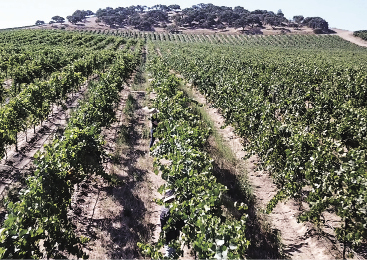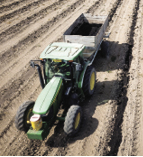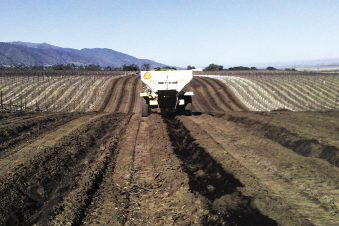Ancient nutrient biochar may boost farming future



California may be primed to become a production hotbed for a lightweight black residue that has helped vast rainforests thrive on infertile soils.
The material is biochar. It is a potentially valuable soil enhancement that can be produced from biomass of forest waste or dead orchards and vineyards.
Its production dates to ancient techniques originated in the Amazon basin. There, in the terra preta or black earth, dense tree and plants grew with help of high-charcoal content nurtured by indigenous soil management using deteriorating organic matter.
Now potential benefits of integrating biochar into all aspects of farming operations are being considered in California. The concept was presented to farmers, food processors, scientists and inventors gathered at the International Agri-Center in Tulare.
“I am trying to get the conversation started within agricultural producers,” said Mayo Ryan, founder of Sitos Group, and a biochar manufacturer. “It doesn’t happen without the farmer.”
Modern biochar production results from a process known as pyrolysis, which involves using extreme heat to breakdown biomass without oxygen or fire. The biochar is the residue left when the biomass thermally decomposes.
Farmers can apply biochar during planting, when it can improve soil quality, increase water retention and improve yield. After harvest, they can then convert winery pomace, rice husks, nut hulls or dead vines into biochar for sale to others.
Given the nearly complete ban of orchard burning mandated by the California Air Resources Board by 2025, Ryan is encouraging farmers to look at alternatives for the biomass of orchards removed from production.
“What’s going to happen to all those orchards and vineyards? It is a great opportunity for us as California growers and processors,” he said.
Already some California counties are considering biochar processing plants. A German biochar company, Pyreg, which sponsored the Tulare gathering, was aiming to connect with California growers and processors to discuss its technology.
Pyreg produces multiple-sized units, the largest about the size of a three-car garage, that can cleanly process a variety of biomass materials, including urban green waste.
While individual pyrolysis units are cost-prohibitive for most, growers could form a collective, burning waste and producing biochar for sale, one of two income streams available from biochar. Another is carbon dioxide removal certificates or CORCs, which are carbon credits that can be sold on the global carbon market.
Demand for physical biochar and carbon credits is growing and outweighs supplies, Ryan said.
“It’s time to start thinking about those almond hulls differently because you’re leaving money on the table,” he said. “It is an economic game-changer for us in California.”
Doug Beck, science advisor at Monterey Pacific Inc., a Central Coast vineyard farm management firm, presented the results of an 8-acre trial conducted in a vineyard with sandy soil and harsh growing conditions from 2016-2021.
The results from the field research project, funded by the California Department of Water Resources and administered by the Sonoma Ecology Center, were promising.
Yield increased 45% to 70% over the control block over the years of the trial. The application of biochar mixed with compost had a significant effect on flowering and fruit set.
“Compost and biochar together is kind of like magic,” Beck said.
But a downside was the high trucking costs to transport the biochar from Humboldt County to the project site in King City in the Salinas Valley. As a result, Beck’s advice is “you might as well produce it where you use it.”
Monterey Pacific is looking at building its own biochar production plant and is applying the material to current and new plantings.
Proponents of biochar say they envision its use in a circular agriculture economy, which includes turning biomass waste into value, reducing CO2 emissions and promoting regenerative farming practices through the production and application of certified biochar.
But citrus farmer Joe Russell of Visalia, whose acreage is both organic and transitioning to organic, questions the practicality of applying biochar in established citrus groves.
“I’m the type of guy who would trial it,” he said. “There are a lot of benefits to it, for sure, but it is premature to know what is and isn’t working. I would need to see data to know what the costs and benefits are, to see if it would actually perform.”
The California Department of Food and Agriculture has yet to issue standards for biochar.
Meanwhile, depending on the quality of the pyrolysis process, biochar has varying quality. Because the pH of soil varies throughout the state, farmers may need to customize their biochar before application.
Joseph Gallegos, CEO of UmidaAG, a subsurface irrigation system company, is working with clients who are adding biochar in irrigation trenches at the time of installation. He is also conducting a test plot at California State University, Fresno.
Gallegos said he has witnessed biochar’s benefits and believes it could help farmers battling challenges in times of drought.
“I am starting to realize biochar is a soil structure element that is able to act like a sponge for the different microorganisms in the soil, to give them a home and they can then multiply at greater quantities,” he said. “That’s what I’m seeing as an advantage.
“The enzymes produced are what we want, as they break down the minerals in the soil and make them available to the plant.”
Gallegos said he believes biochar technology will catch on throughout the state over the next decade.
“With the large amount of orchards in California, it will take off,” he said. “Anytime you see a pile of dead trees, traditionally, those have been burned. But with a drive to eliminate burning, biochar is a good path.”
(Lisa McEwen is a reporter in Exeter. She may be contacted at mcewenlisamarie@gmail.com.)




